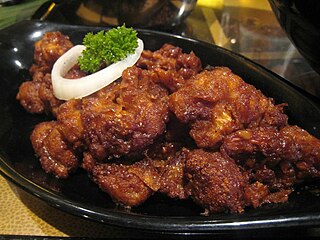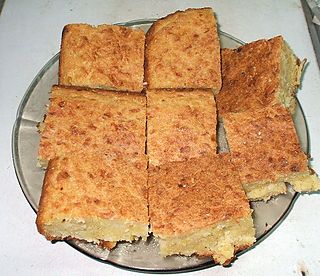Nikkei cuisine is a type of fusion cuisine that combines Japanese and Peruvian elements. Nikkei is the word used to describe immigrants of Japanese origin in Peru. [1]
The Japanese first began their journey through Peru in 1889. [2]
Nikkei food is characterized by its use of the wide variety of ingredients available to Peru. In 1980, this type of food became recognized and since then has been seen as a fusion of Japanese and Peruvian ingredients. Peruvian influences include some basic ingredients such as rocoto, which gives the spicy flavor, yellow chili peppers and limes. On the other hand, the Japanese side of the fusion can be seen in the introduction of vegetable crops and especially rice in the Peruvian land. Not only did they combine products from both cultures, but the Japanese would also use Peruvian foods to make traditional dishes from their homeland. An example of this is the use of yucca for the preparation of mochi, which will give rise to yucamochi, a classic dish of this fusion cuisine. [3]
A cuisine is a style of cooking characterized by distinctive ingredients, techniques and dishes, and usually associated with a specific culture or geographic region. Regional food preparation techniques, customs and ingredients combine to enable dishes unique to a region.

Fusion cuisine is a cuisine that combines elements of different culinary traditions that originate from different countries, regions, or cultures. Cuisines of this type are not categorized according to any one particular cuisine style and have played a part in many contemporary restaurant cuisines since the 1970s.

Ceviche, cebiche, sebiche, or seviche is a dish consisting of fish or shellfish marinated in citrus and seasonings, and is recognized by UNESCO as an expression of Peruvian traditional cuisine and Intangible Cultural Heritage of Humanity. Different versions of ceviche are part of the culinary culture of various Spanish-American countries along the Pacific Ocean where each one is native: Chile, Colombia, Costa Rica, Ecuador, El Salvador, Guatemala, Honduras, Mexico, Nicaragua, Panama and Peru. In Peru it is also considered a flagship dish and cultural heritage.

Fried rice is a dish of cooked rice that has been stir-fried in a wok or a frying pan and is usually mixed with other ingredients such as eggs, vegetables, seafood, or meat. It is often eaten by itself or as an accompaniment to another dish. Fried rice is a popular component of East Asian, Southeast Asian and certain South Asian cuisines, as well as a staple national dish of Indonesia. As a homemade dish, fried rice is typically made with ingredients left over from other dishes, leading to countless variations. Fried rice first developed during the Sui dynasty in China.

Latin American cuisine is the typical foods, beverages, and cooking styles common to many of the countries and cultures in Latin America. Latin America is a highly racially, ethnically, and geographically diverse with varying cuisines. Some items typical of Latin American cuisine include maize-based dishes arepas, empanadas, pupusas, tacos, tamales, tortillas and various salsas and other condiments. Sofrito, a culinary term that originally referred to a specific combination of sautéed or braised aromatics, exists in Latin American cuisine. It refers to a sauce of tomatoes, roasted bell peppers, garlic, onions and herbs. Rice, corn, pasta, bread, plantain, potato, yucca, and beans are also staples in Latin American cuisine.
Peruvian cuisine reflects local practices and ingredients including influences mainly from the indigenous population, including the Andean and Amazonian cuisine, and cuisines brought by immigrants from Europe, Asia, and Africa. Without the familiar ingredients from their home countries, immigrants modified their traditional cuisines by using ingredients available in Peru.

The following outline is provided as an overview of and topical guide to the preparation of food:

California roll or California maki is a uramaki containing imitation crab, avocado, and cucumber. Sometimes crab salad is substituted for the crab stick, and often the outer layer of rice is sprinkled with toasted sesame seeds or roe.

Japanese Peruvians are Peruvian citizens of Japanese origin or ancestry.

Sopa paraguaya is a traditional food of the Paraguayan cuisine similar to corn bread, spongy and soft. Corn flour, cheese, onion and milk or whey are common ingredients. It is a cake rich in caloric and protein content.

Chifa is a Chinese Peruvian culinary tradition based on Cantonese elements fused with traditional Peruvian ingredients and traditions. The term is also used to refer to restaurants that serve the chifa cuisine.

Lomo saltado is a popular, traditional Peruvian dish, a stir fry that typically combines marinated strips of sirloin with onions, tomatoes, french fries, and other ingredients; and is typically served with rice. The dish originated as part of the chifa tradition, the Chinese cuisine of Peru, though its popularity has made it part of the mainstream culture.

The chipa guasu is a cake made with corn grains, onions and Paraguayan cheese. It is one of 70 varieties of chipa, a traditional set of side dishes from Paraguay. It is often served in asados.

Pacific Northwest cuisine is a North American cuisine that is found in the Pacific Northwest, i.e. the states of Oregon, Washington, Idaho and Alaska, as well as the province of British Columbia and the southern portion of the territory of Yukon, reflecting the ethnic makeup of the region, with noticeable influence from Asian and Native American traditions. With significant migration from other regions of the US, influences from Southern cuisine brought by African Americans as well as Mexican-American cuisine as Latinos migrate north from California, can be seen as well.
The global cuisine or world cuisine is a cuisine that is practiced around the world. A cuisine is a characteristic style of cooking practices and traditions, often associated with a specific region, country or culture. To become a global cuisine, a local, regional or national cuisine must spread around the world, its food served worldwide. There have been significant improvements and advances during the 20th century in food preservation, storage, shipping and production, and today many countries, cities and regions have access to their traditional cuisines and many other global cuisines.

Culinary diplomacy, gastrodiplomacy or food diplomacy is a type of cultural diplomacy, which itself is a subset of public diplomacy. Its basic premise is that "the easiest way to win hearts and minds is through the stomach". Official government-sponsored culinary diplomacy programs have been established in Taiwan, South Korea, Singapore, Thailand, Malaysia, Indonesia, Lebanon, Peru, Israel, the United States, Cambodia, Japan, and Nordic countries.

Hot pot or hotpot, also known as steamboat, is a dish of soup/stock kept simmering in a pot by a heat source on the table, accompanied by an array of raw meats, vegetables and soy-based foods which diners quickly cook by dip-boiling in the broth.

The sushi burrito or sushirrito is a type of Japanese-Mexican fusion cuisine. It is typically prepared by rolling sushi ingredients such as fish and vegetables in a wrap and serving like a burrito. The dish is a form of American fusion cuisine inspired by the mixture of Mexican and Japanese cuisine, but is not considered to be authentic to either.